动词不定式todo和doing
To do sth和doing sth是两种不同的动词形式
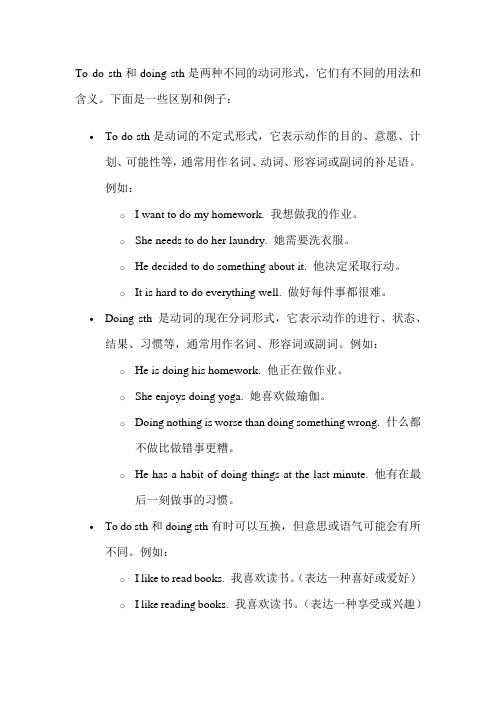
To do sth和doing sth是两种不同的动词形式,它们有不同的用法和含义。
下面是一些区别和例子:•To do sth是动词的不定式形式,它表示动作的目的、意愿、计划、可能性等,通常用作名词、动词、形容词或副词的补足语。
例如:o I want to do my homework. 我想做我的作业。
o She needs to do her laundry. 她需要洗衣服。
o He decided to do something about it. 他决定采取行动。
o It is hard to do everything well. 做好每件事都很难。
•Doing sth是动词的现在分词形式,它表示动作的进行、状态、结果、习惯等,通常用作名词、形容词或副词。
例如:o He is doing his homework. 他正在做作业。
o She enjoys doing yoga. 她喜欢做瑜伽。
o Doing nothing is worse than doing something wrong. 什么都不做比做错事更糟。
o He has a habit of doing things at the last minute. 他有在最后一刻做事的习惯。
•To do sth和doing sth有时可以互换,但意思或语气可能会有所不同。
例如:o I like to read books. 我喜欢读书。
(表达一种喜好或爱好)o I like reading books. 我喜欢读书。
(表达一种享受或兴趣)o He stopped to smoke. 他停下来抽烟。
(表达停止一种动作去做另一种动作)o He stopped smoking. 他戒烟了。
(表达停止一种习惯或状态)请用括号中的动词的适当形式填空:•He likes __________ (play) chess with his friends. 他喜欢和他的朋友们下棋。
to do doing done 非谓语用法

to do doing done 非谓语用法
“To do, doing, done”是英语中一种非常常见的非谓语用法,是指以“to do”、“doing”和“done”开头的动词不定式、现在分词和过去分词形式。
在句子中,这个结构通常用于表示某个特定的动作或状态,而不涉及主谓关系。
下面我们来详细了解一下这三种非谓语用法的具体用法。
一、to do
“To do”是动词不定式,它的基本结构是“to + 动词原形”。
在句子中,“to do”通常用于表示将要发生的动作或未完成的动作。
具体用法如下:
1. 表示目的:例如:
- I went to the store to buy some groceries.(我去商店买食材。
)
- She went to the library to study. (她去图书馆学习。
)
- He called me to ask for some advice.(他打电话给我问建议。
)
二、doing
综上所述,“to do, doing, done”三种非谓语用法在英语中应用广泛,能够帮助我们表达各种场景下的动作或状态。
熟练掌握这三种非谓语用法,能够让我们的语言表达更加丰富和准确。
动词to-do-与doing-的用法区别
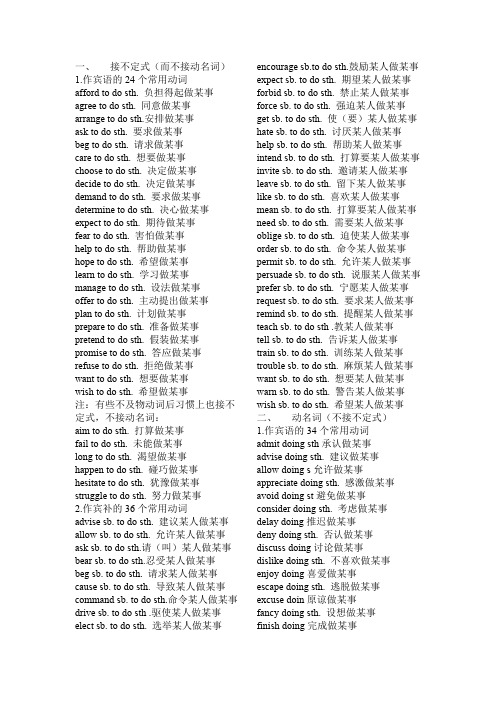
一、接不定式(而不接动名词)1.作宾语的24个常用动词afford to do sth. 负担得起做某事agree to do sth. 同意做某事arrange to do sth.安排做某事ask to do sth. 要求做某事beg to do sth. 请求做某事care to do sth. 想要做某事choose to do sth. 决定做某事decide to do sth. 决定做某事demand to do sth. 要求做某事determine to do sth. 决心做某事expect to do sth. 期待做某事fear to do sth. 害怕做某事help to do sth. 帮助做某事hope to do sth. 希望做某事learn to do sth. 学习做某事manage to do sth. 设法做某事offer to do sth. 主动提出做某事plan to do sth. 计划做某事prepare to do sth. 准备做某事pretend to do sth. 假装做某事promise to do sth. 答应做某事refuse to do sth. 拒绝做某事want to do sth. 想要做某事wish to do sth. 希望做某事注:有些不及物动词后习惯上也接不定式,不接动名词:aim to do sth. 打算做某事fail to do sth. 未能做某事long to do sth. 渴望做某事happen to do sth. 碰巧做某事hesitate to do sth. 犹豫做某事struggle to do sth. 努力做某事2.作宾补的36个常用动词advise sb. to do sth. 建议某人做某事allow sb. to do sth. 允许某人做某事ask sb. to do sth.请(叫)某人做某事bear sb. to do sth.忍受某人做某事beg sb. to do sth. 请求某人做某事cause sb. to do sth. 导致某人做某事command sb. to do sth.命令某人做某事drive sb. to do sth .驱使某人做某事elect sb. to do sth. 选举某人做某事encourage sb.to do sth.鼓励某人做某事expect sb. to do sth. 期望某人做某事forbid sb. to do sth. 禁止某人做某事force sb. to do sth. 强迫某人做某事get sb. to do sth. 使(要)某人做某事hate sb. to do sth. 讨厌某人做某事help sb. to do sth. 帮助某人做某事intend sb. to do sth. 打算要某人做某事invite sb. to do sth. 邀请某人做某事leave sb. to do sth. 留下某人做某事like sb. to do sth. 喜欢某人做某事mean sb. to do sth. 打算要某人做某事need sb. to do sth. 需要某人做某事oblige sb. to do sth. 迫使某人做某事order sb. to do sth. 命令某人做某事permit sb. to do sth. 允许某人做某事persuade sb. to do sth. 说服某人做某事prefer sb. to do sth. 宁愿某人做某事request sb. to do sth. 要求某人做某事remind sb. to do sth. 提醒某人做某事teach sb. to do sth .教某人做某事tell sb. to do sth. 告诉某人做某事train sb. to do sth. 训练某人做某事trouble sb. to do sth. 麻烦某人做某事want sb. to do sth. 想要某人做某事warn sb. to do sth. 警告某人做某事wish sb. to do sth. 希望某人做某事二、动名词(不接不定式)1.作宾语的34个常用动词admit doing sth承认做某事advise doing sth. 建议做某事allow doing s允许做某事appreciate doing sth. 感激做某事avoid doing st避免做某事consider doing sth. 考虑做某事delay doing推迟做某事deny doing sth. 否认做某事discuss doing讨论做某事dislike doing sth. 不喜欢做某事enjoy doing喜爱做某事escape doing sth. 逃脱做某事excuse doin原谅做某事fancy doing sth. 设想做某事finish doing完成做某事给大家推荐一个英语微信群-Empty Your Cup英语微信群是目前学习英语最有效的方法,群里都是说英语,没有半个中文,而且规则非常严格,是一个超级不错的英语学习环境,群里有好多英语超好的超牛逼的人,还有鬼佬和外国美眉。
七年级下册英语todo和doing用法

在七年级下册英语中,todo和doing是两个常用的动词不定式和动词-ing形式,它们在用法上有一些区别。
动词不定式的基本用法动词不定式是一种非谓语动词形式,它可以在句中担任多种成分,如主语、宾语、定语、状语等。
在七年级下册英语中,todo是动词不定式的标准形式,可以用来表示将要做的事情或行为。
例如:To eat breakfast is important for everyone.(吃早餐对每个人都很重要。
)To study hard is necessary for success.(努力学习是成功的必要条件。
)动词-ing形式的基本用法动词-ing形式也称为现在分词,它可以在句中担任多种成分,如定语、表语、宾语补足语等。
在七年级下册英语中,doing是动词-ing形式的缩写形式,可以用来表示正在进行的动作或行为。
例如:Swimming is a good way to keep healthy.(游泳是保持健康的好方法。
)Reading books is my favorite hobby.(读书是我最喜欢的爱好。
)to do和doing的区别to do和doing在用法上有一些区别。
to do通常表示将要做的事情或行为,强调动作的目的性和将来时态;而doing则表示正在进行的动作或行为,强调动作的进行性和现在时态。
例如:I want to go shopping tomorrow.(我想明天去购物。
)He is studying hard now.(他现在正在努力学习。
)需要注意的是,有些动词后面只能接to do作为宾语,如want、plan、hope 等;有些动词后面只能接doing作为宾语,如like、love、hate等。
还有一些动词后面既可以用to do也可以用doing作为宾语,但意义不同,如go on、stop等。
因此,在具体使用时需要注意语境和动词的搭配。
to do sth和 doing sth作宾语的区别
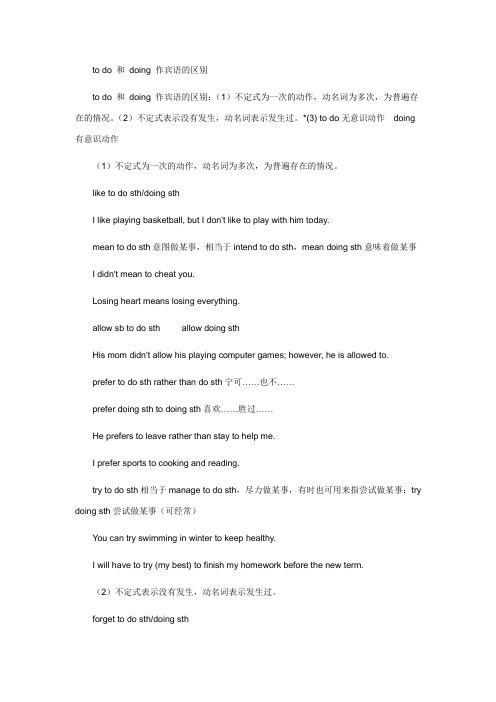
to do 和doing 作宾语的区别to do 和doing 作宾语的区别:(1)不定式为一次的动作,动名词为多次,为普遍存在的情况。
(2)不定式表示没有发生,动名词表示发生过。
*(3) to do无意识动作doing 有意识动作(1)不定式为一次的动作,动名词为多次,为普遍存在的情况。
like to do sth/doing sthI like playing basketball, but I don't like to play with him today.mean to do sth意图做某事,相当于intend to do sth,mean doing sth意味着做某事I didn't mean to cheat you.Losing heart means losing everything.allow sb to do sth allow doing sthHis mom didn't allow his playing computer games; however, he is allowed to.prefer to do sth rather than do sth宁可……也不……prefer doing sth to doing sth喜欢……胜过……He prefers to leave rather than stay to help me.I prefer sports to cooking and reading.try to do sth相当于manage to do sth,尽力做某事,有时也可用来指尝试做某事;try doing sth尝试做某事(可经常)You can try swimming in winter to keep healthy.I will have to try (my best) to finish my homework before the new term.(2)不定式表示没有发生,动名词表示发生过。
todo和doing做主语的区别

在 there is no ... 句型中的主语只能用doing, 并且不能带逻辑主语。如:
There is no denying the fact.
Well, you have said it and there is no taking it back.
上述句子的意思如用不定式to do 则分别为:
动词不定式动词不定式这类句型常用形容词这类句型常用形容词easydifficulthardimportantpossiblewise等作表语为了强调不定式的逻辑主语等作表语为了强调不定式的逻辑主语常在不定式前加常在不定式前加forsb译为译为对某人来说做某事怎么样对某人来说做某事怎么样itbe形容词形容词ofsb
It is impossible to deny the fact.
Well, you have said it and it is impossible for you to take it back.
1. ________well in an interview is an important
A. It
B. I
C. We
D. They
5. It is no use his _________ there, the situation is hopeless now.
A. to go B. to be going
C. going D. having gone
3.
a language in one month is impossible.
(learn)
一般来说,表示比较抽象的行为动作时多用doing; 表示比较具体的某次行为动作时多用不定式to do。
1.
(climb) mountains is interesting.
独立主格中to do,doing,done的区别

独立主格中to do,doing,done的区别1.不定式todo表示动作没有发生或即将发生,且todo动作的执行者是句子的主语。
动词不定式和它前面的名词或代词如果存在着逻辑上的主谓关系,动词不定式则用主动的形式;如果是动宾关系,则用被动形式。
Themanagerlooksworried,manythingstosettle.经理看上去很着急,有这么多的事情要处理。
Thefourofusagreedonadivisionoflabor,eachtotranslateaquarterofthebook.我们四人同意分工干,每人翻译全书的四分之一。
Manytrees,flowers,andgrasstobeplanted,ournewly-builtschoolwilllookevenmorebeautiful.种上许多的树、花和草后,我们新建的学校看上去将更美。
2.动词-ed形式表示动作已经结束,与-ed的主语构成被动关系。
Hewaslisteningattentivelyinclass,hiseyesfixedontheblackboard.他上课专心听讲,眼睛紧盯着黑板。
Theworkersworkedstillharder,theirlivingconditionsgreatlyimproved.由于工人们的生活条件大大提高,他们工作得更起劲了。
Thepresidentassassinated,thewholecountrywasindeepsorrow.总统被谋杀了,举国上下沉浸在悲哀之中。
3.动词-ing式往往表示动作正在进行,-ing的主语和动作构成主动关系. Thefoodbeingcooked,theboywaswatchingTV.小孩一边做饭,一边看电视。
Thegirlstaringathim,hedidn'tknowwhattosay.姑娘两眼望着他,他不知道说什么好。
todo和doing做表语的区别和用法

todo和doing做表语的区别和用法
摘要:
1.区别概述
2.具体用法解析
3.总结与建议
正文:
在日常英语学习中,我们经常会遇到todo和doing这两个词,它们在做表语时有着明显的区别和用法。
本文将为大家详细解析这两个词的区别和用法,并给出一些实用的建议。
一、区别概述
1.词性:todo是动词不定式,而doing是现在分词。
2.语法功能:todo用作表语时,表示一种未发生的动作或打算;doing用作表语时,表示正在进行或发生的动作。
3.逻辑主语:todo后面一般跟名词或代词作逻辑主语,doing后面跟动词作逻辑主语。
二、具体用法解析
1.todo作表语:
例子:
- My job is to do some translations.我的工作是翻译一些东西。
- She came here to do some shopping.她来这里购物。
2.doing作表语:
例子:
- He is studying English.他正在学习英语。
- She is cooking dinner.她正在做饭。
三、总结与建议
1.做表语时,todo表示未发生的动作或打算,doing表示正在进行或发生的动作。
2.根据句意和语境,选择合适的词作表语。
3.加强对于动词不定式和现在分词用法的练习,提高语法掌握程度。
通过以上解析,我们可以更好地理解todo和doing在做表语时的区别和用法。
在实际应用中,要根据句意和语境灵活选用合适的词,从而使句子表达更加准确。
to do 和doing的区别做主语

to do 和doing的区别做主语
从语法角度来讲,to do和doing的最大区别在于它们的词性。
to do是动词不定式,doing是动词现在分词。
从具体用法上来说,to do主要用于表示一件特定的事情,经常表示将要发生的事情
或一件未来计划要做的事情,例如:
I have to do my homework.
我得做我的家庭作业。
They need to do something about this problem.
他们应该做点什么来解决这个问题。
同时,to do还可以用在句子的开头,用来表达必须要做的一件事情,也可以用来表
示让某人一定要做一件事情,例如:
To do list:
待办事项:
1. 打扫房间
2. 洗碗
3. 洗衣服
要做到这一点,你需要非常小心。
然而,doing主要表示正在做,说明正在朝着一个特定的方向努力,表达正在发生的
事情,例如:
We are doing everything we can to make sure our event is a success.
我们正在尽一切努力,确保我们的活动成功。
她正在尽最大努力,让这个项目按计划进行。
因此,我们可以总结出,to do更多地用来表示未来计划要做的事情,而doing则表
示正在做的事情。
动词to do与doing用法区别

动词to do与doing用法区别在英语学习中,动词的 to do 形式和 doing 形式的用法是一个重要且常让人感到困惑的知识点。
理解它们之间的区别对于正确使用英语、表达准确的意思至关重要。
首先,让我们来看看动词不定式 to do 的用法。
动词不定式具有名词、形容词和副词的特征,可以在句子中充当多种成分。
作为主语时,如“To learn English well is not easy”(学好英语不容易。
)此时,它常常表示具体的、一次性的或未来的动作。
作宾语时,常见的动词有 want, hope, decide 等。
例如:“I want to go shopping”(我想去购物。
)这里表达的是一种意愿或计划。
作定语时,它通常放在被修饰词的后面。
比如:“I have a lot of work to do”(我有很多工作要做。
)作状语时,可表示目的、结果等。
“He came here to see me”(他来这儿是为了看我。
)这就是表示目的。
而动词的 ing 形式(doing),也有着丰富的用法。
作主语时,“Reading is a good habit”(阅读是个好习惯。
)它更强调一种一般性、习惯性的动作。
作宾语时,比如 enjoy, finish 等动词后常接 ing 形式。
“I enjoy reading books”(我喜欢读书。
)作定语时,“The swimming pool is very big”(这个游泳池很大。
)作状语时,可以表示时间、原因、伴随等。
“While reading the book, I fell asleep”(在读书的时候,我睡着了。
)在某些动词后,接 to do 和 doing 形式会有不同的含义。
例如,remember to do 表示“记得去做某事(还未做)”,remember doing 表示“记得做过某事”;forget to do 是“忘记去做某事(还未做)”,forget doing 则是“忘记做过某事”。
英语非谓语
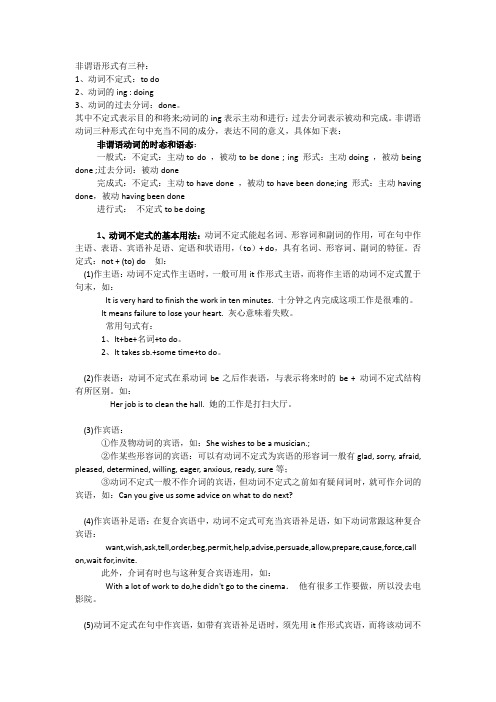
非谓语形式有三种:1、动词不定式:to do2、动词的ing : doing3、动词的过去分词:done。
其中不定式表示目的和将来;动词的ing表示主动和进行;过去分词表示被动和完成。
非谓语动词三种形式在句中充当不同的成分,表达不同的意义,具体如下表:非谓语动词的时态和语态:一般式:不定式:主动to do ,被动to be done ; ing 形式:主动doing ,被动being done ;过去分词:被动done完成式:不定式:主动to have done ,被动to have been done;ing 形式:主动having done,被动having been done进行式:不定式to be doing1、动词不定式的基本用法:动词不定式能起名词、形容词和副词的作用,可在句中作主语、表语、宾语补足语、定语和状语用,(to)+ do,具有名词、形容词、副词的特征。
否定式:not + (to) do 如:(1)作主语:动词不定式作主语时,一般可用it作形式主语,而将作主语的动词不定式置于句末,如:It is very hard to finish the work in ten minutes. 十分钟之内完成这项工作是很难的。
It means failure to lose your heart. 灰心意味着失败。
常用句式有:1、It+be+名词+to do。
2、It takes sb.+some time+to do。
(2)作表语:动词不定式在系动词be之后作表语,与表示将来时的be + 动词不定式结构有所区别。
如:Her job is to clean the hall. 她的工作是打扫大厅。
(3)作宾语:①作及物动词的宾语,如:She wishes to be a musician.;②作某些形容词的宾语:可以有动词不定式为宾语的形容词一般有glad, sorry, afraid, pleased, determined, willing, eager, anxious, ready, sure等;③动词不定式一般不作介词的宾语,但动词不定式之前如有疑问词时,就可作介词的宾语,如:Can you give us some advice on what to do next?(4)作宾语补足语:在复合宾语中,动词不定式可充当宾语补足语,如下动词常跟这种复合宾语:want,wish,ask,tell,order,beg,permit,help,advise,persuade,allow,prepare,cause,force,call on,wait for,invite.此外,介词有时也与这种复合宾语连用,如:With a lot of work to do,he didn't go to the cinema.他有很多工作要做,所以没去电影院。
动词todo与doing的用法区别

动词todo与doing的用法区别一、接不定式(而不接动名词)1.作宾语的24个常用动词afford to do sth. 负担得起做某事agree to do sth. 同意做某事arrange to do sth.安排做某事ask to do sth. 要求做某事beg to do sth. 请求做某事care to do sth. 想要做某事choose to do sth. 选择做某事decide to do sth. 决定做某事demand to do sth. 要求做某事determine to do sth. 决心做某事expect to do sth. 期待做某事fear to do sth. 害怕做某事help to do sth. 帮助做某事hope to do sth. 希望做某事learn to do sth. 学习做某事manage to do sth. 设法做某事offer to do sth. 主动提出做某事plan to do sth. 计划做某事prepare to do sth. 准备做某事pretend to do sth. 假装做某事promise to do sth. 承诺做某事refuse to do sth. 拒绝做某事want to do sth. 想要做某事wish to do sth. 希望做某事注:有些不及物动词后习惯上也接不定式,不接动名词:aim to do sth. 打算做某事fail to do sth. 未能做某事long to do sth. 渴望做某事happen to do sth. 碰巧做某事hesitate to do sth. 犹豫做某事struggle to do sth. 努力做某事2.作宾补的36个常用动词advise sb. to do sth. 建议某人做某事allow sb. to do sth. 允许某人做某事ask sb. to do sth.请(叫)某人做某事bear sb. to do sth.忍受某人做某事beg sb. to do sth. 请求某人做某事cause sb. to do sth. 导致某人做某事command sb. to do sth.命令某人做某事drive sb. to do sth .驱使某人做某事elect sb. to do sth. 选举某人做某事encourage sb. to do sth.鼓励某人做某事expect sb. to do sth. 期望某人做某事forbid sb. to do sth. 禁止某人做某事force sb. to do sth. 强迫某人做某事get sb. to do sth. 使(要)某人做某事hate sb. to do sth. 讨厌某人做某事help sb. to do sth. 帮助某人做某事intend sb. to do sth. 打算要某人做某事invite sb. to do sth. 邀请某人做某事leave sb. to do sth. 留下某人做某事like sb. to do sth. 喜欢某人做某事mean sb. to do sth. 打算要某人做某事need sb. to do sth. 需要某人做某事oblige sb. to do sth. 迫使某人做某事order sb. to do sth. 命令某人做某事permit sb. to do sth. 允许某人做某事persuade sb. to do sth. 说服某人做某事prefer sb. to do sth. 宁愿某人做某事request sb. to do sth. 要求某人做某事remind sb. to do sth. 提醒某人做某事teach sb. to do sth .教某人做某事tell sb. to do sth. 告诉某人做某事train sb. to do sth. 训练某人做某事trouble sb. to do sth. 麻烦某人做某事want sb. to do sth. 想要某人做某事warn sb. to do sth. 警告某人做某事wish sb. to do sth. 希望某人做某事二、动名词(不接不定式)1.作宾语的34个常用动词admit doing sth承认做某事advise doing sth. 建议做某事allow doing sth允许做某事appreciate doing sth. 感激做某事avoid doing sth避免做某事consider doing sth. 考虑做某事delay doing sth推迟做某事deny doing sth. 否认做某事discuss doing sth讨论做某事dislike doing sth. 不喜欢做某事enjoy doing sth喜爱做某事escape doing sth. 逃脱做某事excuse doing sth原谅做某事fancy doing sth. 设想做某事finish doing sth完成做某事forbid doing sth. 禁止做某事forgive doing sth原谅做某事give up doing sth. 放弃做某事imagine doing sth想象做某事keep doing sth. 保持做某事mention doing sth提及做某事mind doing sth. 介意做某事miss doing sth. 错过某事pardon doing sth. 原谅做某事permit doing sth. 允许做某事practice doing sth. 练习做某事prevent doing sth阻止做某事prohibit doing sth. 禁止做某事put off doing sth推迟做某事report doing sth. 报告做某事risk doing sth冒险做某事stop doing sth. 停止做某事suggest doing sth建议做某事understand doing sth. 理解做某2.作宾补的20个常用动词bring sb. doing sth.引起某人做某事catch sb. doing sth. 碰上某人做某事discover sb. doing sth发现某人做某事feel sb. doing sth. 感觉某人做某事find sb. doing sth. 碰上某人做某事get sb. doing sth. 使某人做某事have sb. doing sth使某人做某事hear sb. doing sth. 听见某人做某事keep sb. doing sth使某人不停地做某事listen to sb. doing sth. 听某人做某事look at sb. doing sth看着某人做某事notice sb. doing sth注意到某人做某事observe sb. doing sth观察某人做某事prevent sb. doing sth. 阻止某人做某事see sb. doing sth看见某人做某事send sb. doing sth使某人(突然)做某事set sb. doing sth使(引起)某人做某事start sb. doing sth. 使某人开始做某事stop sb. doing sth阻止某人做某事watch sb. doing sth. 看到某人做某事三.接动词原形作宾补的11个常用动词feel sb. do sth. 感觉某人做某事have sb. do sth. 使某人做某事hear sb. do sth. 听见某人做某事let sb. do sth.让某人做某事listen to sb. do sth. 听着某人做某事look at sb. do sth. 看着某人做某事make sb. do sth. 使某人做某事notice sb. do sth. 注意某人做某事observe sb. do sth. 观察某人做某事see sb. do sth. 看见某人做某事注意两组区别:1. to do 与doing 的区别(1) remember to do sth. 记住要做某事(未做) remember doing sth. 记住曾做过某事(已做)(2) forget to do sth. 忘记要做某事(未做)forget doing sth. 忘记曾做过某事(已做)(3) regret to do sth. 后悔(遗憾)要做某事regret doing sth. 后悔(遗憾)曾做过某事(4) try to do sth. 设法要做某事try doing sth. 做某事试试看有何效果(5) mean to do sth. 打算做某事mean doing sth. 意味着做某事(6) can’t help to do sth. 不能帮助做某事can’t help doing sth. 禁不住做某事(7) go on to do sth. 做完某事后接着做另一事go on doing sth. 继续做一直在做的事(8)stop to do sth. 停下来去做某事stop doing sth 停止正在做的事2. 感官动词+ doing/ do感官动词see, watch, observe, notice, look at, hear, listen to, smell, taste, feel+ do 表示动作的完整性,真实性;+doing 表示动作的连续性,进行性。
非谓语动词之todo和ing的区别
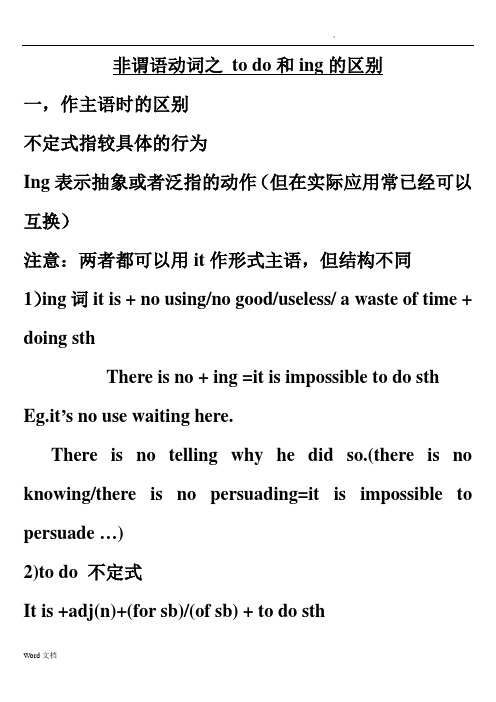
非谓语动词之to do和ing的区别一,作主语时的区别不定式指较具体的行为Ing表示抽象或者泛指的动作(但在实际应用常已经可以互换)注意:两者都可以用it作形式主语,但结构不同1)ing词it is + no using/no good/useless/ a waste of time + doing sthThere is no + ing =it is impossible to do sth Eg.it’s no use waiting here.There is no telling why he did so.(there is no knowing/there is no persuading=it is impossible to persuade …)2)to do 不定式It is +adj(n)+(for sb)/(of sb) + to do sthEg. It is very difficult to drive in the mountains.It is a shame to say like that .二,作表语时的区别不定式强调一次具体动作Ing强调抽象行为三,作宾语不定式agree decline 拒绝refuse offer promise choose decide determine attempt intend manage fail ask hope want tend expect desire wish seek plan prepare pretend learn mean dare arrange demand happen intendIng 词admit stand appreciate avoid finish complete consider delay deny suggest enjoy escape forgive keep mind miss practise risk advise allow permit forbid 或者介词短语的宾语go on insist on , persist in , keep on , take to 喜欢,dream of , get down to , 等等四,作定语不定式后置与修饰词之间有动宾关系必要时要添加介词He is a pleasant fellow to work with .常表示未来发生的动作The man to come our assitance is Mike.在the first, the second , the best, the only thing 等后常加不定式作定语He is always the first to answer questions.Ing词1)多为合成词表中心词的性质Parking lot , sleeping bag, drinking water, cooking oil, driving licence 等2)单个分词前置,短语后置,相当于一个定语从句He is a businessman growing rich in recent years.3)其中现在分词常表示动作正在进行或即将进行过去分词常表示动作已经完成Is this the book written by Mike?五,作状语不定式1) 目的状语=in order to2) 结果状语表意外only to do sth too…to, so…as to . enough…to3) 原因状语一般放在句尾表示引起某种情绪的原(happy,lucky,fortunate, ashamed , surprised, shocked, sorry , glad, delighted, disappointed, anxious, unwise, foolish, rude, considerate, annoyed, bored, puzzled 等等)4)条件状语谓语动词中常有will, must , shall 等5)独立结构to tell the truth, to be ture, to be plain, to cut the matter short, to make matters worse, to be brief, to be exact, to conclude, to be honest, to start with, to sum up 等等Ing 词1)作时间状语相当于when引起的从句Hearing the news, they set off for Shanghai.2) 原因状语从句相当于because引导的从句Overcome with surprise, she was unable to stand.3) 方式或者伴随状语相当于一个并列句He walked down the hill, singing to himself.4) 条件状语从句相当于一个由if引导的从句如果…Given another chance, I will do it better.5) 结果状语从句相当于so that 引导的从句常由逗号自然的结果He turned off the light, seeing nothing.6)让步状语相当于though,although等引导的从句Admitting what I said, I still thought she had n’t tried her best.7)ing词的独立结构有xly speaking , judging from , taking everything into consideration, considering 等8) 这些ing词作状语时,前面有时可以由连接词when, while, unless, as if 等等六补语不定式1)常有固定用法ask request tell invite force press get beg wish prefer want intend expect encourage advise persuade allow forbid permit order urge warn remind 等等2)在两听三使等动词中要省略to,被动现to Ing词表同步进行或者已经完成。
非谓语动词to do和doing的用法
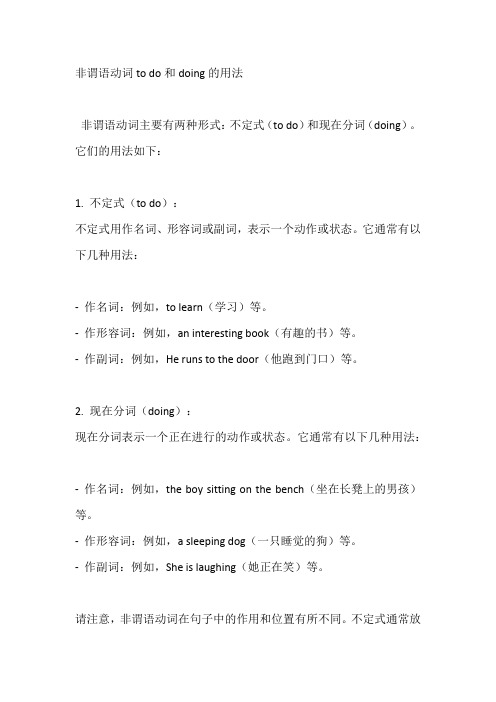
非谓语动词to do和doing的用法
非谓语动词主要有两种形式:不定式(to do)和现在分词(doing)。
它们的用法如下:
1. 不定式(to do):
不定式用作名词、形容词或副词,表示一个动作或状态。
它通常有以下几种用法:
-作名词:例如,to learn(学习)等。
-作形容词:例如,an interesting book(有趣的书)等。
-作副词:例如,He runs to the door(他跑到门口)等。
2. 现在分词(doing):
现在分词表示一个正在进行的动作或状态。
它通常有以下几种用法:
-作名词:例如,the boy sitting on the bench(坐在长凳上的男孩)等。
-作形容词:例如,a sleeping dog(一只睡觉的狗)等。
-作副词:例如,She is laughing(她正在笑)等。
请注意,非谓语动词在句子中的作用和位置有所不同。
不定式通常放
在句子的开头或结尾,而现在分词通常放在句子中间。
此外,现在分词表示动作与谓语动词同时发生,而不定式表示动作将在未来发生。
例如:
- I want to learn English.(我想学习英语。
)
- She is laughing loudly.(她大声笑着。
)
在这些例子中,非谓语动词(不定式和现在分词)在句子中扮演了不同的角色,分别表示未来的动作和学习进行时的动作。
英语重点语法解析动词不定式to do

英语重点语法解析动词不定式to do(一)动词不定式to do和动名词doing在使用时的4个重要区别(1)动名词doing所表示的含义是一般的和抽空的一般的:指不限于指句子中某人或某物所发生的行为,可能是普遍存在的。
[例句] doing vs. to do①As a rule, he prefers walking in the evening. 他通常更喜欢晚上散步。
②She prefers to go this evening. 她更喜欢今晚走。
(表示一次动作)从以上两个例子可以看出,doing 可以表示一般性动作,而to do则表示一次特定的动作。
[例句]Our teachers always pay attention to combining theory with practice. 我们老师经常注意理论结合实际。
在这个句子中的to是作介词,pay attention to是固定搭配,表示“注意、注重...”。
在这个句子中使用的是动名词combining,表示“结合”,句子中在使用doing的形式时,表面上看是老师注意理论结合实际的授课方式,潜在也说明了老师也注意学生在理论结合实际过程中的实际情况。
这就是动名词的作用,表示一般性动作和抽象性动作。
所以有时候可以变为泛指,不仅限于句子中的人或物所发出的行为。
(2)动名词doing和动词不定式to do在有些动词后,表示的含义有所变化①forget(忘记)[例句]He forgot writing the letter. 他忘记了写过那封信。
He forgot to write the letter. 他忘记了(去)写那封信。
(实际上他还没写)②remember(记得)[例句]I remember going there two years ago. 我记得两年前去那边了。
I remember to go there。
我记得去那里。
(实际上他还没去)在这两个例句中明显体现出to do动词不定式表现出将要去做某事的含义。
动词后面加todo和doing的规则

动词后面加todo和doing的规则一、什么是动词后面加todo和doing的规则?动词后面加todo和doing的规则是指在英语中,动词后面可以加上todo和doing,来表示将要做或正在进行的动作。
这种用法在语法中被称为不定式和现在分词的形式。
二、动词后面加todo的规则1. 表示将要做的动作:动词原形+to do例如:I want to do my homework.译文:我想做我的作业。
2. 表示喜好、意愿或建议:动词原形+to do例如:I like to swim in the summer.译文:我喜欢夏天游泳。
3. 表示计划或安排:动词原形+to do例如:We have a meeting to attend tomorrow.译文:我们明天有一个会议要参加。
4. 表示目的:动词原形+to do例如:I went to the store to buy some groceries.译文:我去商店买了些杂货。
5. 表示能力:动词原形+to do例如:She can't afford to buy a new car.译文:她买不起一辆新车。
三、动词后面加doing的规则1. 表示正在进行的动作:动词的现在分词形式+doing例如:I am reading a book.译文:我正在读一本书。
2. 表示习惯性的动作:动词的现在分词形式+doing例如:She is always talking on the phone.译文:她总是在电话里聊天。
3. 表示进行中的状态:be+动词的现在分词形式+doing例如:He is studying for his exams.译文:他正在为考试而学习。
4. 表示时间、条件或原因:with/without+动词的现在分词形式+doing例如:With the rain pouring down, we decided to stay indoors.译文:由于雨下得很大,我们决定呆在室内。
- 1、下载文档前请自行甄别文档内容的完整性,平台不提供额外的编辑、内容补充、找答案等附加服务。
- 2、"仅部分预览"的文档,不可在线预览部分如存在完整性等问题,可反馈申请退款(可完整预览的文档不适用该条件!)。
- 3、如文档侵犯您的权益,请联系客服反馈,我们会尽快为您处理(人工客服工作时间:9:00-18:30)。
动词不定式to do 和doing 首先是加to do 的动词
attempt企图enable能够neglect忽视
afford负担得起demand要求long渴望
arrange安排destine注定mean意欲,打算
begin开始expect期望omit忽略,漏
appear似乎,显得determine决定manage设法
cease停止hate憎恨,厌恶pretend假装
ask问dread害怕need需要
agree同意desire愿望love爱
swear宣誓volunteer志愿wish希望
bear承受endeavor努力offer提供
beg请求fail不能plan计划
bother扰乱;烦恼forget忘记prefer喜欢,宁愿
care关心,喜欢happen碰巧prepare准备
decide决定learn学习regret抱歉,遗憾
choose选择hesitate犹豫profess表明
claim要求hope希望promise承诺,允许
start开始undertake承接want想要
consent同意,赞同intend想要refuse拒绝
decide决定learn学习vow起
contrive设法,图谋incline有…倾向propose提议
seek找,寻觅try试图
下面的动词要求不定式做宾补:动词+宾语+动词不定式
ask要求,邀请get请,得到prompt促使
allow允许forbid禁止prefer喜欢,宁愿
announce宣布force强迫press迫使
bride 收买inspire鼓舞request请求
assist协助hate憎恶pronounce断定,表示
advise劝告exhort告诫,勉励pray请求
authorize授权,委托help帮助recommend劝告,推荐bear容忍implore恳求remind提醒
beg请求induce引诱report报告
compel强迫invite吸引,邀请,summon传唤
command命令intend想要,企图show 显示
drive驱赶mean意欲,打算train训练
cause引起instruct指示require要求
deserve应受leave使,让tell告诉
direct指导like喜欢tempt劝诱
entitle有资格order命令warn告诫
enable使能够need需要urge激励,力说
encourage鼓励oblige不得不want想要
condemn指责,谴责lead引起,使得teach教
entreat恳求permit允许wish希望
有少数动词只能用动名词作宾语(doing)
acknowledge承认,自认cease 停止mention说到,讲到
admit 承认tolerate忍受dislike不喜欢,讨厌
advocate:提倡,主张complete完成dread可怕
appreciate 感激,欣赏confess坦白endure忍受
avoid避免contemplate细想enjoy享有,喜爱
bear忍受defer拖延envy嫉妒
can’t help不禁delay延迟escape逃跑,逃避
can’t stand受不了deny否认excuse借口
consider 考虑detest嫌恶fancy幻想,爱好
favor 造成,偏爱mind 介意repent悔悟
figure描绘,计算miss错过resent怨恨
finish完成,结束不得pardon原谅,饶恕resist抵抗,阻止
forgive原谅permit 允许resume恢复
imagine设想postpone延迟,延期risk冒险
involve卷入,包含practise 实行,实践suggest建议
hate讨厌prevent阻止save营救,储蓄
keep保持quit放弃停止stand坚持,忍受
loathe非常讨厌,厌恶recall回想
例如:I appreciate having been given the opportunity to study abroad two years ago.我很感激两年前给我出国学习的机会。
有些动词后使用动名词和动词不定式作宾语的差别
1)forget to do 忘记要去做某事(此事未做)
forget doing忘记做过某事(此事已做过或已发生)
2)stop to do 停止、中断(某件事),目的是去做另一件事
stop doing 停止正在或经常做的事
3)remember to do 记住去做某事(未做)
remember doing记得做过某事(已做)
4) regret to do对要做的事遗憾
regret doing对做过的事遗憾、后悔
5)try to do努力、企图做某事
try doing试验、试一试某种办法
6) mean to do打算,有意要…
mean doing意味着
7)go on to do 继而(去做另外一件事情)
go on doing 继续(原先没有做完的事情)
8)propose to do 打算(要做某事)
propose doing建议(做某事)
9) like /love/hate/ prefer +to do 表示具体行为(特例);+doing sth 表示抽象、倾向概念(习惯)Mike likes swimming in the summer, but this summer he likes to play PingPang.
(注)如果这些动词前有should一词,其后宾语只跟不定式,不能跟动名词。
例如:
I should like to see him tomorrow.
10) need, want, deserve(值得) +动名词表被动意义;+不定式被动态表示“要(修、清理等)”意思。
Don’t you remember seeing the man before你不记得以前见过那个人吗
You must remember to leave tomorrow.你可要记着是明天动身。
I don’t regret telling her what I thought.我不后悔给她讲过我的想法。
(已讲过)
I regret to have to do this,but I have no choice.我很遗憾必须这样去做,我实在没办法。
(未做但要做)
You must try to be more careful.你可要多加小心。
Let’s try doing the work some other way.让我们试一试用另外一种办法来做这工作。
I didn’t mean to hurt your feeling.我没想要伤害你的感情(打算,意愿)。
This illness will mean(your)going to hospital.得了这种病(你)就要进医院。
(意味着)
(mean doing=equals to 相当于)。
